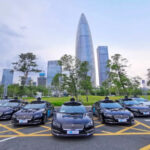The past impressions of China’s artificial intelligence (AI) developments as widely seen from industry expos and conferences over recent years – a human-like robot making a cappuccino or a robotic arm playing the piano – are ready to take the next step, in the post-COVID-19 era. AI is going deeper.
AI technologies have made increasing contributions in the first half of the year via contact-tracing of confirmed coronavirus cases, mapping the spread of the virus and handling a sea of data when the country was pulling out all the stops in an effort to fight the health crisis.
Smart robotics, developed by OrionStar, a robotics company backed by Chinese high-tech firm Cheetah Mobile, has witnessed increasing adoption of its technologies during recent months.
With more than 10,000 robots deployed in over 20 different industrial scenarios, the total number of service visits has exceeded 200 million and the average number of daily voice interactions hit 5 million as of May this year, Cheetah Mobile said in a statement sent to the Global Times over the weekend.
In the healthcare sector, the company’s robots have allowed for remote diagnosis and delivery of medical supplies. The robots were dispatched to hospitals to help reduce the burden on medical workers by delivering medicine, guiding patients and measuring patients’ temperatures.
Despite the overall business disruptions caused by the outbreak of COVID-19 in China, the US-listed Cheetah Mobile saw its revenues in the AI business reach 31.76 million yuan ($4.55 million) in the first quarter, up 12 percent quarter-on-quarter, thanks to a surging demand for AI robots.
Shun Yu, an independent industry analyst, told the Global Times that a stronger demand for AI has been witnessed during the epidemic, which is conducive both to the more widespread applications in the industry and the fundamental research taking place.
In the post-coronavirus era, AI can play the role of a new engine to stimulate economic growth, said Shun.
The number of enterprises with AI-related businesses went up in the first half of the year. China saw more than 140,000 newly registered AI enterprises, surging 31.35 percent year-on-year, data from database query platform Tianyancha.com showed.
However, it should not be ignored that behind the booming AI industry obstacles and risks are looming, pushing the sector to cool from the heat it had enjoyed in the past few years. The commercialization of AI start-ups has become difficult amid the health crisis and subsequent financing cool-down.
Ge Qi, vice president of CloudMinds, a SoftBank-backed cloud robotics and AI start-up, told the Global Times that it is undeniable that the first half of the year has shown rich opportunities for AI to become more market-oriented and turning to online resolutions has also become the norm.
“But the other side of the coin is that the COVID-19 pandemic has driven customers to slash orders, leading to tight cash flow for AI start-ups that are in need of financing to back R&D,” said Ge.
Chinese AI upstart iFlyTek reported a net loss of 131 million yuan in the January-to-March period, compared with a profit of 102 million yuan a year earlier, which the company attributed to coronavirus-induced delays in deliveries, according to its first-quarter earnings report.
However, iFlyTek said the pandemic will not hit its businesses in the long term, as the AI industry and the company’s businesses are discovering an increasingly favorable environment for development.
A way out
As a focal point of technology contest between the world’s powers, especially China and the US, AI development has become the center of attention. Meanwhile, the US government has relentlessly rolled out discriminative measures by adding Chinese high-tech firms to its so-called Entity List.
The AI market in China is expected to reach $11.9 billion by 2023, an industry white paper said at the end of last year, pointing out that a lack of AI talent and high-quality data are the primary challenges.
According to the observation of Ge during the World Artificial Intelligence Conference (WAIC) held in Shanghai between July 9 and 11, which used a combination of online and offline delivery methods due to the COVID-19 pandemic, the heat of bilateral communications among enterprises and researchers on AI has to some extent reduced.
Ge’s CloudMinds and an array of research institutes and high-tech firms, including facial recognition start-up CloudWalk, were added by the US Department of Commerce’s Bureau of Industry and Security to its Entity List in May, banning the entities from accessing US technology exports.
“The US’ policy has indeed had some impacts on those firms, but it will not play a long-term role in beating the increasingly competitive AI sector in China,” Shun noted.
A CloudWalk spokesperson told Global Times that the firm has sufficient supply chain reserves for the next one or two years and it has established strategic cooperation with Chinese companies at home including Huawei.
“We have prepared to speed up our localization process,” the spokesperson said, while calling for integrated efforts from the government and all players along the industrial chain to join forces to withstand the challenges.
Betting on the opportunities ahead brought by the country’s new infrastructure projects in a number of key fields including 5G, cloud computing and industrial internet, the spokesperson said: “AI, on top of infrastructure, will join the real economy to boost the efficiency of various industries.”
A medic at a hospital in Zhengzhou, Central China’s Henan Province, uses the AI robot provided by Cheetah Mobile to handle daily work in January. Photo: Courtesy of Cheetah Mobile



